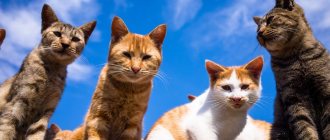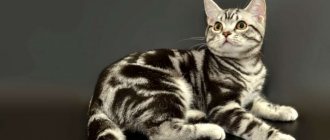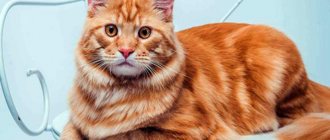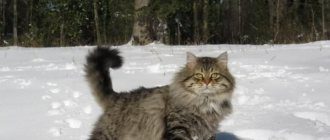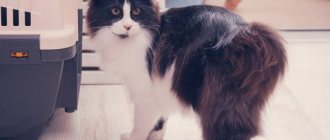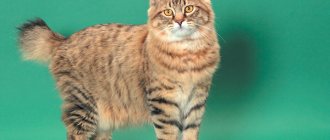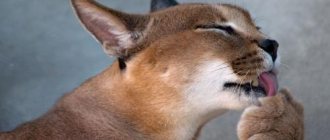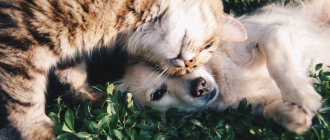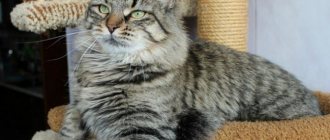Cats and cats of a bright red color are simply magnificent creatures that charm people with their unusual color. The red color of the fur is a symbol of joy and positivity. There are a lot of signs associated with red cats. They say that a bright cat can charge you with energy and bring prosperity to your home. In this article we will look at the breeds of red cats in more detail.
Many breeds have a red coat color in their standards. Colors come in different colors - from black-red, to white-red or spotted tri-color with bright fiery tan marks. Typically, red cats are not completely monochromatic; they always have stripes or spots.
Red cats: Maine Coon breed
The largest cats of all pets are Maine Coons. They become adults, unlike other breeds, within 4 years. All other felines mature at the end of two years, becoming fully mature animals capable of reproducing. Externally, the cat is similar to a lynx and a raccoon, and therefore it is called the Maine raccoon cat. Maine Coon colors vary. But the brightest and most delightful are the red ones, as if they had descended from the bright sun.
© shutterstock
These purebred ginger cats are not at all aggressive. They get along well with other felines, are friends with children, and affectionate with adults. The intelligence and affection of the Maine Coon is compared to that of a dog. Cats of this breed are extremely kind and love to communicate, which can sometimes even be mistaken for intrusiveness. Maine Coon cats wait for their owners from work, love to sleep in a shared bed, follow their heels and do not want to be alone for a minute. Among the representatives of cats of this breed there may be individuals born with polydactyly - a large number of fingers.
History of the Norwegian Forest Cat breed
Norwegian Forest Cat
As you can guess from the name (in different dialects of the Norwegian language, “forest” sounds differently, so there are two options in use - Norsk skogkatt or Norsk skaukatt), these fluffy beauties come from the Scandinavian forests. Scientists today do not have accurate data on how long they live next to humans. The hypothesis is very popular that the countdown dates back to the 16th century, when Angora cats arrived in Western Europe from Ankara. The harsh climate of the peninsula and the need to climb trees a lot led to the appearance of undercoat, strengthening of the claws and the formation of an athletic physique.
However, we cannot completely discount the possibility that, under the influence of external factors in the new environment, the Angora mutation responsible for the length of the coat occurred and became established in Felis silvestris grampia, regardless of its Mediterranean relatives. And those same wild Scottish cats were brought to the territory of modern Norway by the Vikings, who colonized the Shetland, Orkney and Hebrides islands back in the 9th-10th centuries. This version is supported by the traditional image of the leader of the Valkyries, the goddess of fertility, love and war, Freya - the ancient sagas depict her in a chariot drawn by two cats, whose bushy tails are clearly reminiscent of our today's heroes.
In the 19th and first half of the 20th centuries, many Norwegian and Swedish families kept these cats as pets. In the 1930s, after their triumphant appearance at an international exhibition in Germany, serious work began on the phenotype of the breed, the goal of which was to preserve the best natural qualities and weed out undesirable traits. But with the outbreak of World War II, this had to be forgotten, and in the second half of the 40s, the very existence of the Norwegians was threatened due to spontaneous crossing with other cats. The situation was brought under control only by the efforts of enthusiasts. A special committee was created that gave permission for breeding only to those owners whose animals met the standard. The efforts of the Norwegian Association of Pedigree Cat Fanciers were rewarded: King Olav V recognized Skogkatts as the official breed of the country, and in 1977 Pans Truls received the coveted registration with the International Cat Federation (FIFe). By the way, it was he, together with Pippa Skogpuss, who is considered the founder of the modern breed. Born from their union, Pans Silver became the father of 12 litters at once and today is mentioned in almost every pedigree of a purebred Norwegian.
World recognition gave breeders the right to draw up international pedigrees. At the same time, the export of Norwegian forest cats abroad began. Now most of these pets live in Sweden, but other European countries are not far behind. In the USA, local Maine Coons (which, by the way, some are inclined to consider as descendants of the Norwegians) are too serious competition for guests from overseas to speak of real popularity. In Russia, among large breeds, Siberians are still numerically superior, although specialized nurseries have already been opened in Moscow, St. Petersburg, Novosibirsk, Vladivostok and some other cities.
Persian cats: aristocracy and greatness
The Persian cat always means aristocracy and greatness. The breed is ancient, its roots come from the beginning of the 12th century. A characteristic feature of the breed is a depressed nose, located at the same level as the eyes. Silky fur is the pride of the Persians. Its colors come in different colors, but the most elite ones are gray, lilac, black, red, blue and cream. And the brightest and most in demand today are red Persians with large, intelligent eyes.
Persian cats are very loyal animals; they never leave their owners’ side; they explore the area, following on their owner’s heels. They love communication, finding a common language with all residents of the apartment or house. Persian cats do not like to be alone; they will happily travel with their owner, so as not to be left alone at home. This is a measured and balanced genus of cats.
Scottish fold
Scottish Fold is a breed of white fluffy cats that is very popular. The standard does not allow the presence of smoky spots. The pet's coat should be pure white. A special feature of the breed is the smoky spots that appear at an early age in kittens. But over time they completely disappear. Scottish cats have a pink tint to their pads and nose, and their eyes can be blue or gold.
The animals attract attention with their incredibly soft plush fur. Cats' ears have a characteristic curve. The breed appeared in the sixties of the last century as a result of a random mutation. Since then they began to actively breed her. It is worth noting that the Scottish Field is a classic sofa breed. Its representatives adore comfort and warmth. But at the same time, cats show independence. A characteristic feature of the animals is their squeaky voice. Cute pets get along well not only with all family members, but also with other animals. Cats love to play, but very often behave independently.
American Curls
Among the famous breeds of red-colored cats are the American Curls. These cats have a unique generic indicator - ears turned inside out. The first representative was discovered in California on a farm half a century ago. A kitten of original appearance was transferred to the exhibition and registered in the TICA system.
© shutterstock
American Curls have a long frame and a round head shape; the four-legged dog is compactly formed and has a well-built physique. Curls have excellent health, which is typical for the breed.
Cats can wear almost all colors. The cat's fur looks great :
- In brown
- silver,
- white,
- blue
- and, of course, in red color.
This breed of red cats is well suited for keeping by the male half of our society, as it does not require special care. Animals are very attached to the owner, love home fun, and can fulfill some of the owner’s whims, for example, bringing slippers, jumping over barriers.
Feature of white cats
White pets look very beautiful. Many housewives want to have such a pet. Standards for all breeds require pure color without blemishes or opalines. Only small marks are possible, which appear at a young age and then disappear. This is worth remembering when choosing a pet. White fur is caused by the absence of a certain pigment – melanin.
Some people find it incredibly difficult to keep a white-haired cat because of the constant need to keep it clean. Actually this is not true. If you want to have such a pet, carefully study all the breeds. Among them you can find those representatives whose coat is not prone to contamination. You can choose an animal with long or short hair. It all depends on your preferences. In general, caring for white pets is not as difficult as it might seem at first glance.
Little red cats Napoleons
A unique furry animal is a cat of the Napoleon breed. Why this name? Because fluffies are small. And as everyone knows, the great commander was short in stature. In appearance, Napoleon cats are similar to Persian cats and munchkins.
The weight of cats of this breed is 2-3 kg, they have a flattened muzzle and large paws. Napoleon cats come in two varieties: classic - they have long legs and extreme - they have short legs. There are four main types of color: gray, white, peach and red. Pets do not like to be alone and unattended; they are trusting and peaceful, and can easily get along with the other inhabitants of the apartment.
© shutterstock
Care and maintenance
If you decide to purchase a pet such as a Scottish Fold Fold, first organize the placement of the cat.
It is necessary to buy a tray, food and toys in advance so that the baby can immediately adapt to the new place. The list of mandatory care measures includes:
- Combing. Use a stiff or wire brush. Comb several times, both with and against the coat. These cats love to be brushed against the grain.
- Ears. Clean them carefully at least once a week. They sometimes have excessive sulfur output, which must be removed.
- Eyes. Lightly wipe your eyes with the end of a cotton pad soaked in boiled water once a week.
- Claws. They often know how to use a scratching post. But if you are not accustomed, try to trim once a month.
The animals are not usually sickly, but they do have genetic problems. Bone diseases are the most common. Moreover, these sores can occur at any age - the skeleton may become deformed, the tail may become inactive, or the limbs will begin to thicken. This is called osteochondrodysplasia.
If you notice a change in your pet’s gait, see that he reacts painfully to touching his tail, has no desire to jump, or has a squat appearance in his figure, contact your veterinarian immediately.
It is necessary to monitor the pet's health. In addition, they are susceptible to heart disease, bronchitis, and diabetes. These diseases are not congenital, and also require timely diagnosis and treatment.
Cymrik breed: fluffy red beauties
In the 60s, felinologists noticed the Cymrik cat breed. They have lush fur, a rounded head, compact body build, developed muscles, and the main difference is that they do not have a tail. Instead of this part of the body there is a small cartilage.
The real wealth is the animal's fur. It is long, and under it there is a thick undercoat. The furry pets of this breed come in different colors: delicate white, majestic black, playful tabby and sunny red. Pets have a balanced character, they can be trained, and are good at learning various tricks. Thanks to its friendly nature, the pet communicates with every member of the family. Domestic cats with red fur are very cute creatures, fluffy and bright.
Games with a kitten
The little kitten is very playful by nature. In the first days of his life, he plays with his mother cat and his brothers. This game is training for the upcoming hunt, developing dexterity and reaction speed. This is inherent in a small fluffy ball by nature itself. Therefore, when you get a kitten, you must play with it.
The main type of cat game is hunting, which is accompanied by tracking down a target and attacking with a jump. Knowing this, it is necessary to create just such a play environment in which the baby can at the same time train in his hunting abilities and enjoy spending time with the owner.
The most popular and favorite game of kittens is “butterfly”. To play this game you need to take a thick thread or rope and tie a paper butterfly to its end. When the rope with the butterfly twitches or moves along the floor, the kitten will begin to hunt with great enthusiasm and pounce on the butterfly, trying to claw it with its small claws.
Another exciting game for a kitten is a small ball or marble. For example, you can use a table tennis ball - it is quite bouncy and slippery, which will allow your pet to happily chase it around the house.
In addition, many different toys can be found in specialized pet stores. For cats, it is best to purchase toys made from natural materials and without small protruding parts. So, an interesting and funny toy for a furry purr would be a purchased wind-up mouse made of felt, which the kitten will run after with great excitement.
Be sure to pay attention to your pet, play with it, care for it and watch its development so that it grows healthy, active and happy.
Ginger British cat
The birthplace of the British cat is England. The epic of genesis is surrounded by complete mysteries. Today, the variety is very popular; many Russian families have it. The British are strong and large, often weighing 4-6 kg.
Classic colors: lilac and blue, but there are enough options to choose a furry friend of an original color. Today the red sunny color of the British cat is in great demand and is in demand among breeders.
British cats have a balanced character, they are aristocratic, independent and intelligent.
Care and nutrition
You need to care for a red and fluffy domestic cat in the same way as a pet of any other color. It is necessary to monitor your pet's diet so that it does not turn into an arrogant fat cat, like the famous cartoon character named Garfield. You will need to take into account the characteristics of the breed and ask the breeders what to feed the Maine Coon or Turkish Van, and also find out in more detail what disease the pet is susceptible to.
Important! According to experts, ginger cats tolerate anesthesia and similar drugs for pain relief less well than others. This fact has not been proven scientifically, but nevertheless it exists
Every pet needs stable and proper nutrition, healthy sleep in a place specially equipped for it, and regular examinations by a veterinarian.
Red representatives of the Ural Rex
The Ural Rex breed is considered unique, as it was obtained naturally; humans did not participate in its development. An unusual curly-haired cat lived in the Urals, then she was brought to a nursery in Moscow, where breeders began improving the breed.
© shutterstock
Ural rexes are medium-sized. The cat's fur is curled in the form of thick small curls. Often you come across Ural rexes of chocolate, blue, tortoiseshell, and bright red shades. Representatives of this breed like to communicate, they love to sleep in their master's bed, they treat family guests calmly, and they can allow themselves to be petted.
Color options
Other tones that descendants inherit from their ancestors also participate in the formation of coat shades. All attempts by breeders to create a uniform color were unsuccessful. Any red color looks patterned.
- White and tan is the most popular option. The white gene in this color combination is dominant and suppresses the white spotting of solid colors.
- Gray-red appears if one of the parents has the D gene, which is responsible for color intensity. The most spectacular combination is red, white and gray. This color is often found among outbred cats.
- A red tabby or tabby appears as fine lines, a clear outline of the upper and lower eyelids, and an "M" shape on the animal's forehead.
- The red tabby is a very varied and interesting color that looks like a shaded tabby. Contrast comes in different intensities.
- Black and red - tortoiseshell. Its carriers are cats. The color is often found in Persians and Maine Coons.
Wild cat Caracal
The caracal is a breed of wild cat. Some brave people like to keep these animals at home, but they need conditions close to natural, and therefore special spacious enclosures are equipped for them. Cats of this breed are nocturnal. The appearance of the pets is very similar to the lynx. The highlight is the presence of charming dark tassels on the ears. The weight of the animals is about 20 kg.
The colors of animals of this breed range from sand to bright brown. Also found, but less frequently, are bright red individuals. Caracals are self-sufficient and self-confident, they do not recognize impudence. Cats are friendly and gentle towards family friends.
Caracals can be given treatments in the form of warm baths; they love to swim. The main thing for a red pet of this breed is to raise it correctly from childhood, then it will be friendly, gentle, non-aggressive and energetic.
Raising a cat
To fully communicate with an animal, it is necessary for it to learn its name. When you communicate with a baby, he comprehends a certain amount of words and phrases. This is how he develops a unique vocabulary. Cats learn a certain set of words: some perceive entire phrases and cope with the task given to them by their owner quite successfully; others make do with one-syllable commands. It should be remembered that these graceful animals always react to the emotional connotation of the phrase or command with which they are addressed.
The little red cat quickly remembers his nickname, as well as the names of family members and their friends. He can easily distinguish the command “walk” from the command “place” or “come to me.” It is recommended to practice such commands not only at home, but also while walking on the street.
In order to teach a kitten to eat at a certain time, it is necessary to begin training from the first months of its stay in the house. At this age, cats are very receptive, so each feeding can be used to practice basic commands. First, you can tap the saucer on the floor and call the kitten by its name - this will be a pleasant signal for the fluffy. He will quickly remember it and then learn to run headlong when you call. After a couple of weeks, along with saying his name, you can add the command “come to me,” and when the kitten comes running to you, give him something to eat and caress.
At a young age, the brain of a furry creature, like a sponge, absorbs information coming to it from the outside world and from its owner. During this period of time, there is no need to demand from the kitten the perfect execution of commands, but they need to be constantly practiced.
To develop the understanding of the “cannot” and “can” commands in a small predator, they should be performed only in the specified sequence. At home and during walks on the street, it is recommended to practice the “no” command, which should be pronounced in a stern voice, since the baby will react not so much to the words as to the intonation with which the command was pronounced. If the pet continues to perform an action that you have forbidden it, you need to stop it and repeat the command “no” in a voice again, but under no circumstances scream - the kitten can hear well.
In addition, sign language can also be used. If the kitten understands your request and stops misbehaving, praise him and caress him with the words “well done,” spoken in a soft manner and calm intonation.
Somali red cats
The Somali cat is also a “domestic fox.” Her ancestor was the Abyssinian cat. Nobody knows when and how this breed came about. Some breeders believe that this animal is the result of genetic mutations, others believe that the female was crossed with a long-haired breed. The Somali red cat is aesthetic and flexible. This is an animal with large pointed ears, which are topped with small tassels.
A distinctive feature of the breed is the frill, which is located on the neck and tail. Colors of Somali cats
challenging and worthy of attention. The coat can be beige, brown, orange, red and red. All these tones, when mixed, will create a ticked color. Somalis enjoy frolicking, running and jumping. They feel great alone, without requiring special attention.
Breed standard
The World Cat Federation has prescribed the following standard of appearance for Persian cats.
- The squat, large or medium-sized body is supported by low, stable paws. The chest and shoulders should be broad and muscular.
- The thick coat, up to 12 centimeters long, is fine and silky. The neck, shoulders and chest have a collar-shaped coat of fur.
- The not very long fluffy tail is slightly rounded at the end.
- The head is round and massive, of good proportions, with a voluminous skull.
- The forehead should be prominent and the cheeks should be full.
- Persians have a short and wide, slightly snub nose with very open nostrils.
- Strongly built jaws and chin.
- The ears are small, set wide and low on the skull. They should be rounded at the ends, with beautifully growing tufts of hair.
- The eyes are large, very expressive, shiny, round and spaced far apart. Their color depends on the specific coat color (they can be blue, golden and even multi-colored).
- The coat can be either one color or consist of two or three shades.
- The weight of the animals varies from 3 to 7 kg.
Siberian cats of red colors
The homeland of the Siberian cat is clear from its name, although they were brought from the south. The Siberian has a thick coat and a dense undercoat. The warm “fur coat” was formed by the harsh climate. Its colors come in different solid colors, for example, bright red, as well as bicolors, tricolors, and tabbies.
© shutterstock
The cat is neat and respectful, and therefore owners usually do not encounter obstacles in raising it. Can adapt everywhere - will not leave any opportunity for any rodent. The animal is sociable and loves children. Siberian cats get along well with other cats or dogs, but rodents and rabbits are not their friends.
Instilling good habits
The first thing you need to teach your furry animal is to go to the toilet in a specially designated place. This, despite popular belief, is a fairly easy process, but it will require a lot of your patience. By nature, the cat family is very clean, so its representatives carefully bury the products of their vital activity. However, any animal in the house must have a place for a toilet.
The main mistakes that new kitten owners make:
- They let this process take its course, and then punish the animal and try to teach it to defecate in the right place;
- From the very beginning, they punish the cat for the puddles he left and poke his nose into them.
Such methods of toilet training will only lead to the ginger cat starting to shit all over the rooms and in hard-to-reach places. It will be very difficult to correct this later.
In order to properly toilet train your purring friend, you need to:
- Choose a potty for the cat. The most suitable is a plastic vessel that is easy to clean. The edges of the pot should be low so that the kitten can easily jump into it. Toilets for kittens with a mesh are very convenient, thanks to which the animal has clean paws;
- The cat litter box should be located, if possible, in a quiet place, away from household appliances that make noise. It is necessary to ensure that the cat is not interfered with by children or dogs;
- Take the time to catch your kitten just as he is about to go to the toilet. Direct it to the place prepared for this. Make sure that every time the fluffy intends to do his wet business, he only goes to the toilet and does not choose other places in the house;
- After the kitten goes to the toilet for the first time according to its natural needs, pet and praise it, and also treat it with something tasty.
Mr. Cat recommends: adaptation of a new tenant
Little kittens adapt to a new environment quite quickly, but your pet needs to make this period as easy as possible. At first he will miss his mother and look for her, but after a few days he will start exploring the expanses of the apartment.
If you do not plan to let your tailed pet into your bed, then it is necessary to accustom him to a house or bedding from the first days.
The animal will choose a place to sleep itself, and a house should be placed there or a special bedding should be laid.
Moving and being separated from mom is stressful for a small animal. At first, he may refuse to eat and drink. You need to accustom him gradually, over time he will begin to eat normally.
The pet will also choose its own place to go to the toilet. He may start meowing loudly while circling in one place. This happens if the nursery or breeder has already trained him to use a tray. Where he has designated a place for himself, the pot is placed. Sometimes a kitten can quietly pee in some corner, and the owner simply will not notice it.
In any case, it is almost useless to accustom a kitten to a tray placed in a place chosen by the owner: he will go to the place where he did it for the first time.
In this matter, a person will have to adapt to a small pet. If the cat is not accustomed to the tray, then he needs to be shown several times what this item is intended for: as soon as the animal begins to “dig” a hole for its business, you need to place it in the tray.
Caring for newborn kittens
If it so happens that you have to care for a kitten from birth, then you need to take several points into account. A cat can give its child everything it needs; the owner’s task is to create comfortable conditions for the woman in labor and her offspring.
Newborn blind kittens should be placed in a warm place, without drafts. It is necessary to ensure the absence of bright light, loud sounds and other irritants. The cat can handle the rest on its own. There is no need to take kittens while they are breastfed: depending on their character, the cat may refuse to feed them further, sensing foreign odors.

